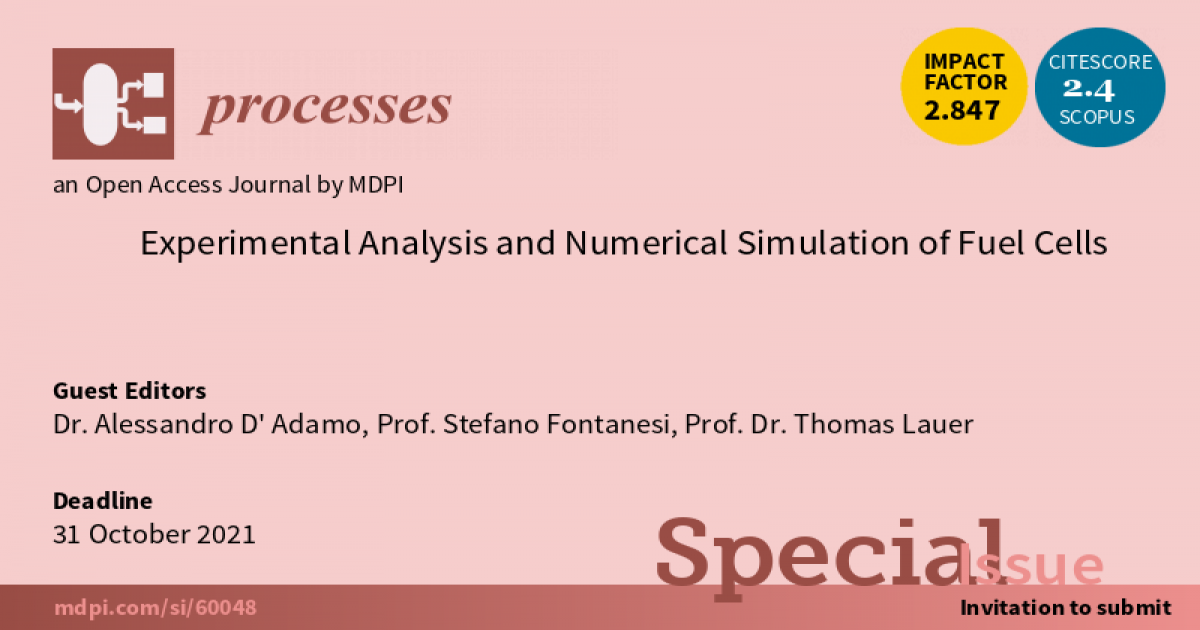Experimental Analysis and Numerical Simulation of Fuel Cells
A special issue of Processes (ISSN 2227-9717). This special issue belongs to the section "Energy Systems".
Deadline for manuscript submissions: closed (15 April 2022) | Viewed by 18723

Special Issue Editors
Interests: CFD simulation of reactive flows; CFD simulation of fuel cells; combustion simulation in internal combustion engines; chemistry modelling
Special Issues, Collections and Topics in MDPI journals
Interests: CFD simulation; CFD simulation of fuel cells; combustion simulation in internal combustion engines; energy systems
Special Issues, Collections and Topics in MDPI journals
Special Issue Information
Dear Colleagues,
The advances witnessed in recent years in fuel cells technology have drawn the power engineering research community towards this attractive and environmentally friendly energy generation system. The ever-increasing need for a transition from carbon-based energy supply towards greener and more sustainable sources (especially for but not limited to the transportation sector) motivates the renovated interest in developing advanced fuel cell systems.
The fundamental understanding of the interaction between fluid mechanics (e.g., reactants delivery to the active backing layers) and electro-chemistry (e.g. current density, electric losses) is a mandatory step towards highly efficient fuel cell design. Moreover, the multiple directions in material properties, membrane and layer thickness, and gas channel design add complexity to identifying multiple optimal configurations.
Dedicated experiments and virtual multi-physics/multi-scale models offer unprecedented possibilities to investigate the interplay of all the governing phenomena, representing a key enabler towards the establishment of fuel cells-based systems in the next generation of sustainable power generation systems.
This Special Issue on “Experimental and Numerical Simulation of Fuel Cell” aims to collect advancements in the field of experimental and numerical study of fuel cell systems with a focus on high efficiency. Topics include but are not limited to the following:
- Fuel cell validation cases as well as complex MEA/stacks;
- Specific applications for mobile as well as stationary power generation;
- Advancements on innovative materials for membrane and catalyst layers;
- Multi-phase modelling for liquid/gas water transport;
- Heat generation problems and thermal management;
- Small/large-scale system studies (g. single cell as well as full-stack studies).
Prof. Stefano Fontanesi
Prof. Thomas Lauer
Guest Editors
Manuscript Submission Information
Manuscripts should be submitted online at www.mdpi.com by registering and logging in to this website. Once you are registered, click here to go to the submission form. Manuscripts can be submitted until the deadline. All submissions that pass pre-check are peer-reviewed. Accepted papers will be published continuously in the journal (as soon as accepted) and will be listed together on the special issue website. Research articles, review articles as well as short communications are invited. For planned papers, a title and short abstract (about 100 words) can be sent to the Editorial Office for announcement on this website.
Submitted manuscripts should not have been published previously, nor be under consideration for publication elsewhere (except conference proceedings papers). All manuscripts are thoroughly refereed through a single-blind peer-review process. A guide for authors and other relevant information for submission of manuscripts is available on the Instructions for Authors page. Processes is an international peer-reviewed open access monthly journal published by MDPI.
Please visit the Instructions for Authors page before submitting a manuscript. The Article Processing Charge (APC) for publication in this open access journal is 2400 CHF (Swiss Francs). Submitted papers should be well formatted and use good English. Authors may use MDPI's English editing service prior to publication or during author revisions.
Keywords
- Fuel cells validation
- Fuel cell simulation
- Fuel cell materials
- Fuel cells design
- Fuel cells optimization
- Water management in fuel cells
- Heat generation in fuel cells
Benefits of Publishing in a Special Issue
- Ease of navigation: Grouping papers by topic helps scholars navigate broad scope journals more efficiently.
- Greater discoverability: Special Issues support the reach and impact of scientific research. Articles in Special Issues are more discoverable and cited more frequently.
- Expansion of research network: Special Issues facilitate connections among authors, fostering scientific collaborations.
- External promotion: Articles in Special Issues are often promoted through the journal's social media, increasing their visibility.
- e-Book format: Special Issues with more than 10 articles can be published as dedicated e-books, ensuring wide and rapid dissemination.
Further information on MDPI's Special Issue polices can be found here.







